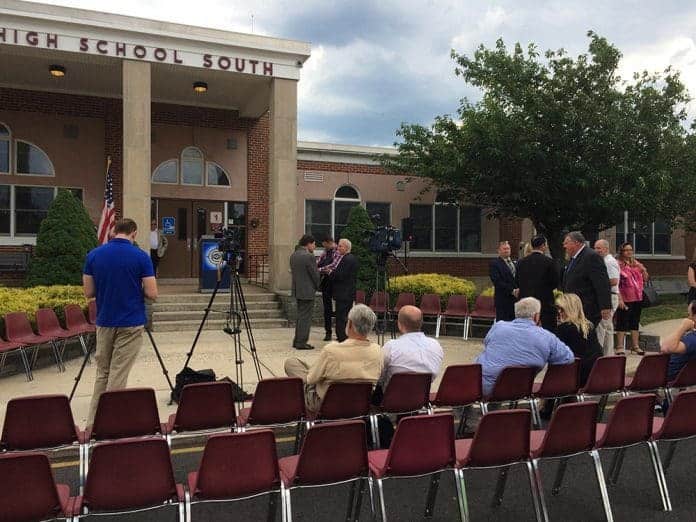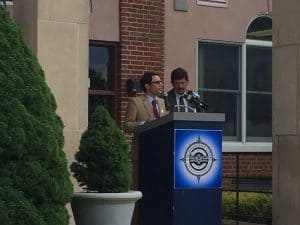
By Chris Lundy and Judy Smestad-Nunn
TOMS RIVER – School officials and lawmakers are protesting a proposed state budget plan that would cut funding to some local districts, and redirect it to other districts.
The sponsors of that plan said that the funding is going down because those districts’ enrollments are down. The plan was crafted by Senate President Stephen Sweeney (D-3) and Assembly Speaker Vincent Prieto (D-32).
Toms River would face a cut of approximately $3.3 million. (Its total budget, including all taxes and funding, is $240 million.) Brick could see a loss of $2.1 million. Manchester Township is slated to lose $177,000.
“We are not recommending taking state aid from other districts in any way,” said Toms River Superintendent David Healy at a press conference held at High School South. They just want the same aid they received last year. “We remain optimistic that the governor will respond to our plea.”

Resetting state aid at the lower number for upcoming years “will no doubt devastate this community. There is no way the district can absorb this plan and continue to provide a thorough and efficient education.” He warned that staff could be cut, parents could be charged for athletics, and activities could be reduced.
The district’s business administrator, William Doering, said that the funding formula is flawed. It’s based on a town’s ability to pay, but Toms River is calculated to be more wealthy than it really is. Similarly, other towns are calculated to be less wealthy than they really are.
He also argued that Toms River has one of the lowest cost per pupil, and the funding is going toward towns with some of the highest.
Senators James Holzapfel and Greg McGuckin and Assemblyman David Wolfe (all R-10th) also spoke out against the measure at the press conference.
The lawmakers also took issue with $25 million in funding to pre-kindergarten schools in those districts. Although educators support pre-k as a building block for future education, it is not mandated by the state.
“How is it that people who, by law, have to be educated,” are losing money to pre-k students who, by law, don’t have to be educated, Holzapfel said.
McGuckin asked what districts are getting that pre-kindergarten money.
Wolfe said “It’s not a Republican and Democratic standoff. It’s an issue of fairness.”
The Toms River district organized a protest in Trenton, but this was ultimately cancelled as they did not receive approval to hold the protest.
In an interview by phone, Dan Leonard, Beachwood’s representative on the Toms River Board of Education, said that the district has met with state officials for months. They tried every avenue, so they now have to attempt grand statements like press conferences and protests. “The district did everything procedurally that they could. We can’t do it without the public.”
“This district has stretched every penny. We have the lowest per pupil cost,” he said. Instead of being praised for being frugal, they are being penalized.
Brick Mayor John Ducey said at the press conference that the town lost $341 million in residential ratables from Superstorm Sandy, and is still trying to recover from it.
“It’s not fair that a smaller group of people are paying a higher amount of taxes,” he said. “Every single community should be treated the same.”
Brick Board of Education President John Lamela said in a press release that possible state aid budget cuts would have a “devastating impact” to the district.
“The budget numbers were given to our district back in February,” Lamela said in a June 19 press release. “The Board, in collaboration with the Administration, worked hard to keep our tax rate low, prepare a budget that provides an excellent opportunity for our students, and makes some much needed capital improvements.”
The proposed $2.2 million loss would result in deep cuts to the budget, which Lamela said was not only unfair but would hurt the students of Brick Township.
Brick has been one of the lowest spending districts in the state while still providing a high quality of education for its students, Lamela said, and “instead of celebrating our successes we are being punished for our staff and students hard work.”
Lamela urged the residents of Brick, and the surrounding districts that are still recovering from the effects of Superstorm Sandy, to contact their legislators “to do the right thing and fight this unfair and hurtful proposal.”
Aid Based On Enrollment
Attempts to contact Sweeney and Prieto were not successful as of press time. However, Mark Magyar, policy director for the New Jersey Senate Democrats returned the call and spoke on their behalf. He said that the funding formula is more in line with what it is supposed to be. Extra aid was stripped away in order to make it fair to everyone.
The reason that some towns are losing aid is because their student enrollment is going down, he said. The funding formula dates back to 2008, and was still using those enrollment figures. Things have changed.
“It’s a 15-year-old formula based on what districts looked like 15 years ago,” he said.

Toms River had 17,169 students in the 2008-2009 school year. They were down to 15,620 in 2016-2017. This is a reduction of 9 percent.
Brick had 10,283 students in 2008-2009. They were down to 8,753 in 2016-2017. This is a reduction of 14.9 percent.
Manchester had 3,334 students in 2008-2009. They were down to 2,945 in 2016-2017. This is a reduction of 11.7 percent.
In New Jersey, 73 percent of students attend districts that are underfunded, Magyar said. There are 27 percent of students that are receiving more aid than they should.
He countered the argument that these cuts are politically motivated, citing several Republican territories that would be receiving more aid.
Indeed, some of them are in Ocean County. Central Regional and Southern Regional are both seeing increases in aid. Stafford Township and Tuckerton’s aid will be flat. Ocean Gate and Long Beach Island will see slight increases.






